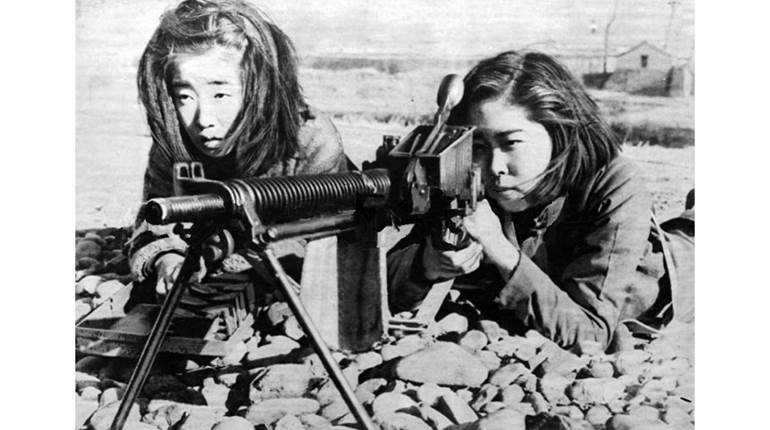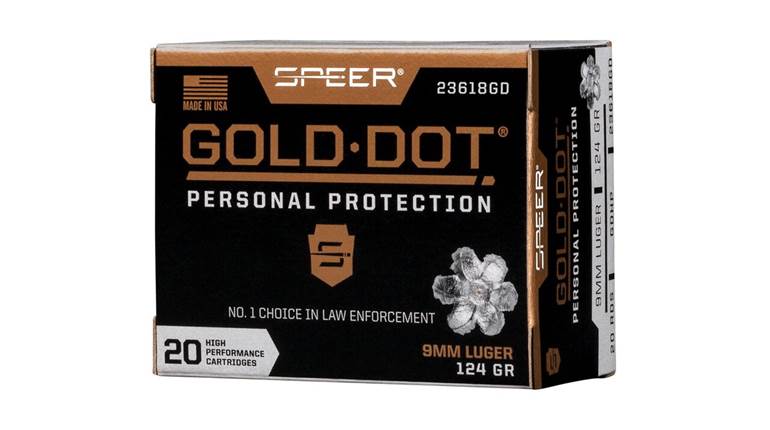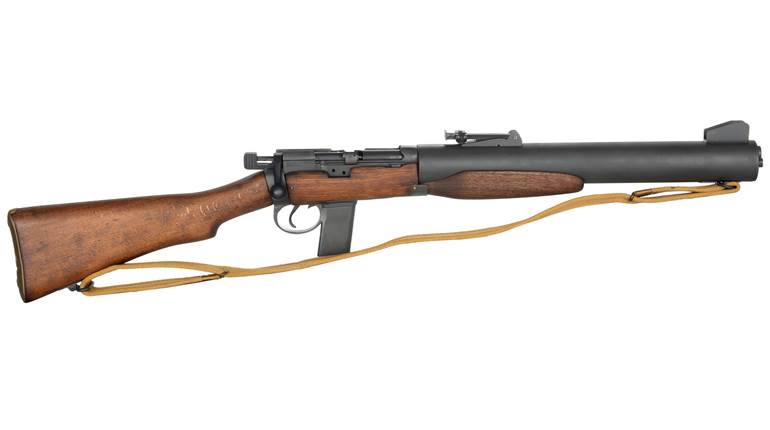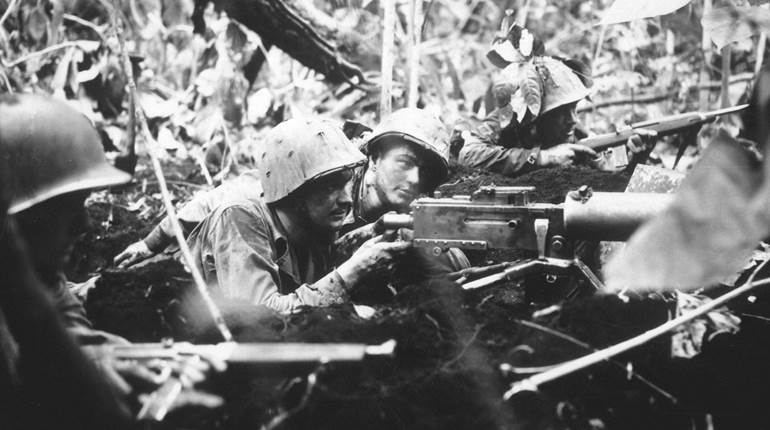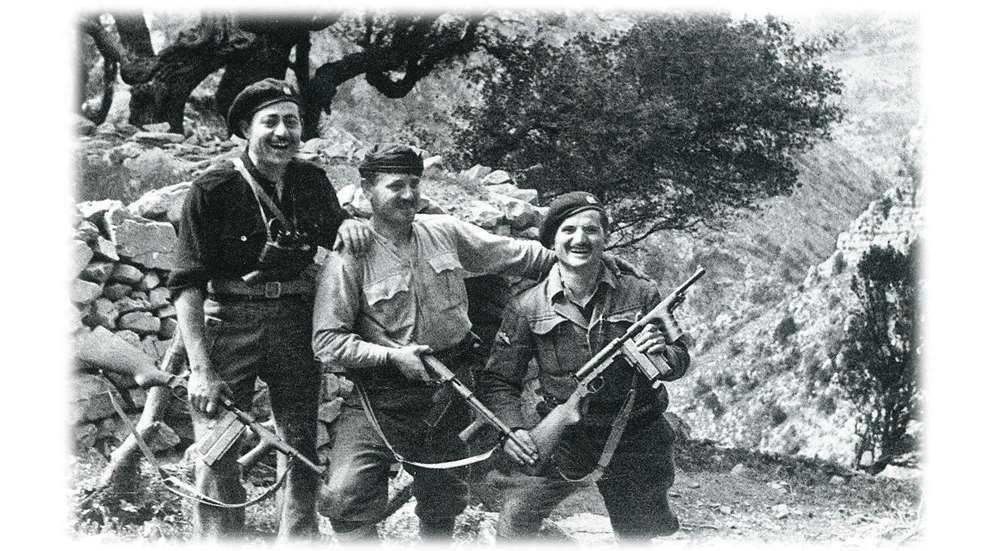
At the time of America’s declaration of war after Pearl Harbor, there were two types of submachine guns in Uncle Sam’s arsenal; the Thompson and the Reising. Introduced in 1921, the Thompson was arguably the best-known submachine gun in the world. Initially manufactured by Colt in the early 1920s, the Model 1921 Thompson was not looked upon with much favor by the U.S. military until the eve of the Second World War. A slightly changed variant, the M1928A1, was manufactured by the Savage Arms Company beginning in early 1940, eventually followed by the Auto-Ordnance Corporation. The M1928A1 Thompson was standardized by both the U.S. Army, Navy and Marine Corps during WWII. The Reising submachine gun, developed by the noted arms designer Eugene Reising and manufactured by the Harrington & Richardson Arms Company, was procured in rather sizeable numbers beginning in late 1941 by the U.S. Marine Corps, largely due to a shortage of Thompsons at the time.
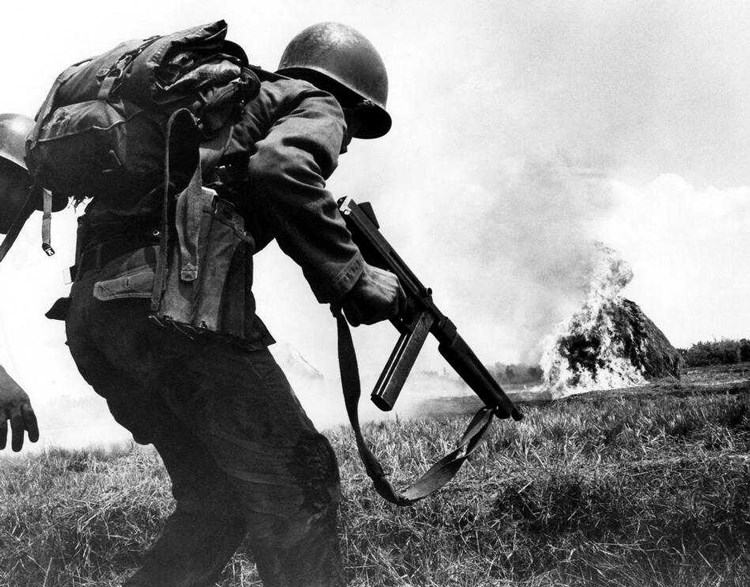
The Thompson is one of the most-recognizable submachine guns of World War II, but its cost and complexity of manufacture led the U.S. Ordnance department to seek alternatives.
Like all such arms, the Thompson and Reising had their strengths and weaknesses. The Thompson was sturdy and reliable but was expensive and time-consuming to manufacture and was about as heavy as an M1 Garand Rifle. The Reising was much lighter, less expensive to manufacture and quite accurate, particularly in the semi-automatic mode. On the other hand, it was a relatively complex firearm with a number of parts that required hand-fitting and had a troubling propensity to malfunction when exposed to even moderate amounts of muck and mire.
It soon became apparent to the ordnance department that what was really needed was a submachine gun that was at least as reliable as the aging Thompson but was not as heavy and was capable of being manufactured faster and cheaper. It also obviously had to be less prone than the Reising to malfunctioning under anything less-than-ideal conditions. In early 1942, the Thompson was substantially redesigned to reduce manufacturing time and cost. The new model, the “M1,” was soon followed by the slightly changed “M1A1.” However, the simplified Thompson was actually little more than a stop-gap measure, as it was still a relatively expensive gun and weighed only slightly less than the M1928A1.
In order to find a new submachine gun with the desired attributes, Ordnance considered other designs from domestic arms designers. One such firearm was developed by Carl G. Swebilius, affiliated with the High Standard Manufacturing Company. Swebilius filed a patent in late 1940 that was assigned to High Standard. The gun, chambered for the 9 mm Luger cartridge, utilized the typical blowback operation and fired from an open bolt. It weighed (unloaded) about 9 lbs., 3 ozs. and was capable of semiautomatic operation and the rate of fire in the full-automatic mode was approximately 700 rounds per minute.
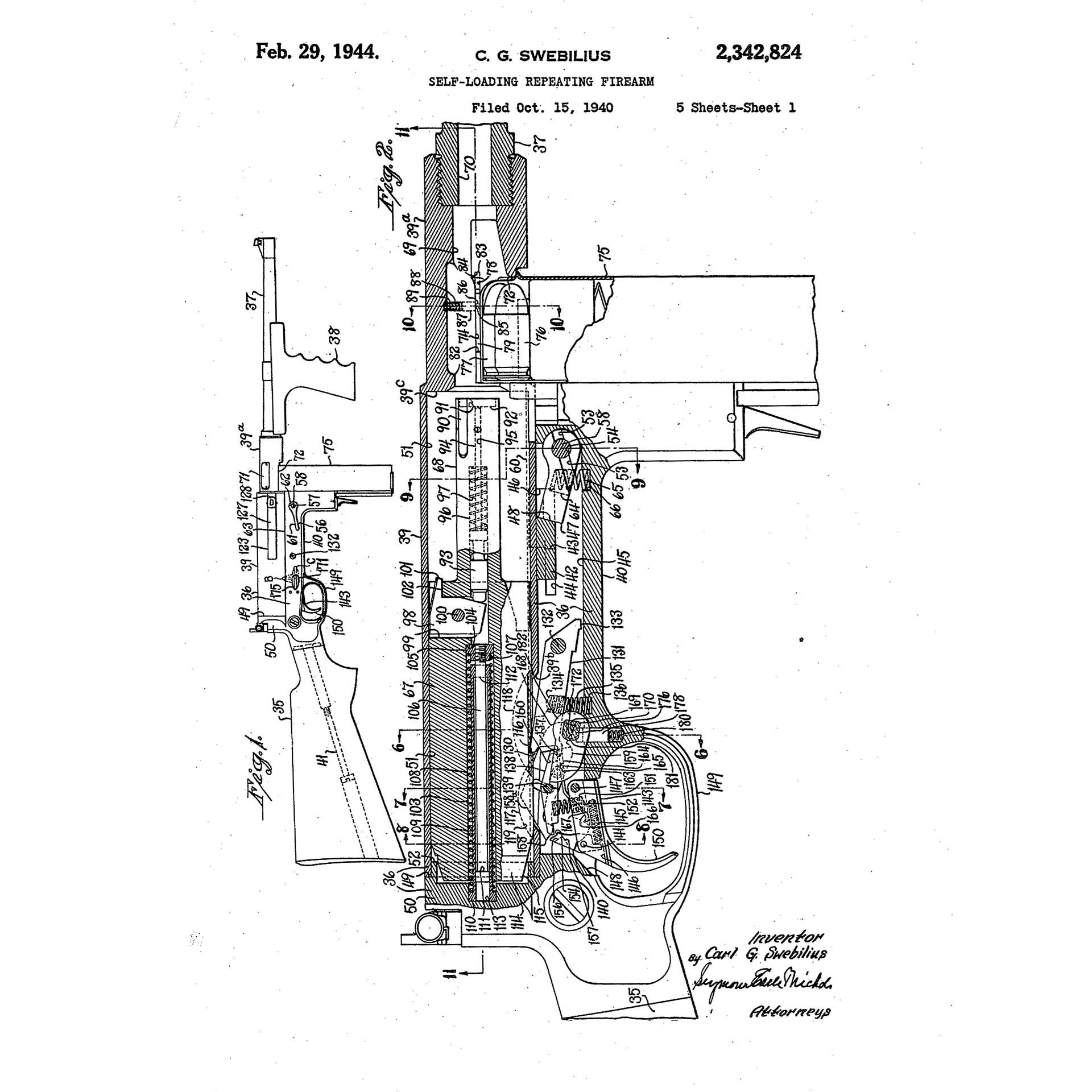 The gun was very well made with a commercial-quality, blued finish. A signature feature was two 25-round magazines brazed together. This permitted an empty magazine to be quickly replaced with the other attached magazine. The gun was originally designated as the “Model UD of 1941” (United Defense), since production was scheduled to begin in 1941. Plans were formulated for High Standard to produce the new submachine gun and have it marketed to foreign nations by the United Defense Supply Corporation. In November 1941, before High Standard began mass production of the new submachine gun, the company accepted large orders from the British government for the manufacture of .50-cal. machine guns.
The gun was very well made with a commercial-quality, blued finish. A signature feature was two 25-round magazines brazed together. This permitted an empty magazine to be quickly replaced with the other attached magazine. The gun was originally designated as the “Model UD of 1941” (United Defense), since production was scheduled to begin in 1941. Plans were formulated for High Standard to produce the new submachine gun and have it marketed to foreign nations by the United Defense Supply Corporation. In November 1941, before High Standard began mass production of the new submachine gun, the company accepted large orders from the British government for the manufacture of .50-cal. machine guns.
Before approaching allied nations to buy the new submachine gun, High Standard fabricated one of the guns, chambered for the .45 ACP cartridge, to determine if the U.S. Army Ordnance Department would have any interest in the gun as a replacement for, or supplement to, the Thompson and/or Reising submachine guns. Army Ordnance tested the High Standard submachine gun at Aberdeen Proving Ground, and the overall impression of the weapon was favorable. In order to correct a few problems encountered during the initial testing, an improved model was developed. Six of the improved .45-cal. prototypes were fabricated and tested by the Armored Force Board and the Cavalry Board.
 Although the improved High Standard submachine gun reportedly functioned relatively well in the subsequent U.S. Army testing, the previously-mentioned M1 Thompson submachine gun was scheduled to go into production. Thus, a “No Requirement” recommendation for the High Standard submachine gun was forthcoming after the conclusion of various Army Ordnance tests. Despite the High Standard gun’s performance, it had several negative aspects in common with the Thompson submachine gun; it was rather expensive to manufacture and was relatively heavy.
Although the improved High Standard submachine gun reportedly functioned relatively well in the subsequent U.S. Army testing, the previously-mentioned M1 Thompson submachine gun was scheduled to go into production. Thus, a “No Requirement” recommendation for the High Standard submachine gun was forthcoming after the conclusion of various Army Ordnance tests. Despite the High Standard gun’s performance, it had several negative aspects in common with the Thompson submachine gun; it was rather expensive to manufacture and was relatively heavy.
Other prototype submachine guns tested during this period included a design submitted by the Auto-Ordnance Corporation, one of the makers of the Thompson. Designated as the “T2,” the Auto-Ordnance gun utilized a standard Thompson box magazine and had a cyclical rate of 600 .45 ACP rounds per minute. It had only 31 components and it was believed the T2 could be manufactured for less than $50 per gun. Unfortunately, despite its seemingly attractive attributes, the gun exhibited a number of breakages and malfunctions so, after the conclusion of the testing, the Ordnance Committee recommended that “…no further consideration be given…” to the experimental T2.
A submachine gun designed and patented by George J. Hyde was also tested at Aberdeen. Originally developed at the Inland Division of General Motors, the gun was designated as the “Hyde-Inland 1,” which was soon followed by the slightly improved “Hyde-Inland 2.” The Hyde-Inland submachine gun had a typical blowback action and was also chambered for the standard .45 ACP cartridge. It had a fully automatic rate of fire of approximately 570 rounds per minute and used standard Thompson submachine gun box magazines. The gun had a wooden stock and short handguard and weighed about 9.25 lbs. While it wasn’t any lighter than the High Standard UD Model 1941, it did weigh a bit less than the Thompson and Ordnance believed it could be made faster and at a lower cost.
 During testing at Aberdeen, the Hyde-Inland submachine gun was judged to be superior to the M1928A1 and M1 Thompsons in the mud and dirt tests and proved to be more accurate than any of the other submachine guns tested. It was recommended that the Hyde-Inland 2 be adopted as “Substitute Standard” in April 1942 and designated “Gun, Submachine, Caliber .45, M2.” Since Inland had become heavily involved in manufacture of the M1 carbine by this time, the Marlin Firearms Company was given a production contract for 164,500 M2 submachine guns. Marlin experienced a great deal of trouble getting the M2 into mass production, and only about 400 guns had been made when the contract was cancelled in June, 1943.
During testing at Aberdeen, the Hyde-Inland submachine gun was judged to be superior to the M1928A1 and M1 Thompsons in the mud and dirt tests and proved to be more accurate than any of the other submachine guns tested. It was recommended that the Hyde-Inland 2 be adopted as “Substitute Standard” in April 1942 and designated “Gun, Submachine, Caliber .45, M2.” Since Inland had become heavily involved in manufacture of the M1 carbine by this time, the Marlin Firearms Company was given a production contract for 164,500 M2 submachine guns. Marlin experienced a great deal of trouble getting the M2 into mass production, and only about 400 guns had been made when the contract was cancelled in June, 1943.
Since none of the prototype submachine guns tested (the High Standard Model UD 1941, the Auto-Ordnance T2 or the Inland/Marlin M2) were found to be acceptable, Ordnance turned its attention to another submachine gun that had also been designed largely by George Hyde. By this time, submachine guns fielded by our by our allies and adversaries such as the British STEN and the German MP40 that utilized manufacturing shortcuts such as stamped and welded sheet-metal construction to drastically reduce manufacturing time and expense, but were still capable of satisfactory performance, had made an impression on the U.S. Army Ordnance Department.
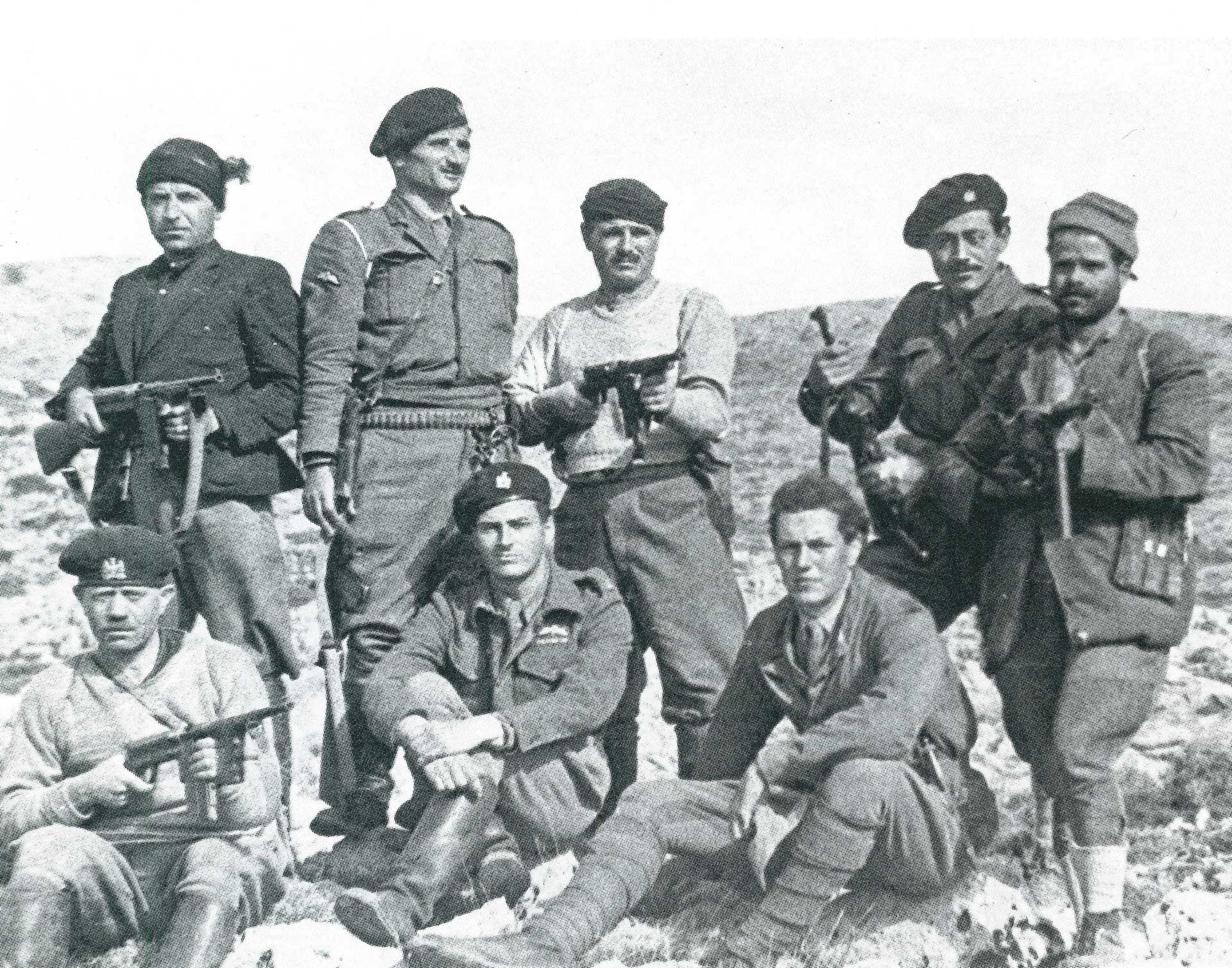 The new gun designed by Hyde and his team was, like the British Sten, constructed largely from stamped and welded sheet metal. Extensive testing confirmed that the gun functioned very well and could be made for a fraction of the cost, and much faster, than even the simplified M1 Thompson, as well as any of the prototype submachine guns that had been tested. In early 1943, the “M3” submachine gun was adopted, and production contracts were granted to the Guide Lamp Division of General Motors. However, initial manufacturing difficulties resulted in some delay in delivery of the new gun, and the M3 did not see its first real combat use until the Normandy invasion in June 1944. The Thompson continued to be the primary American submachine gun for most of the war.
The new gun designed by Hyde and his team was, like the British Sten, constructed largely from stamped and welded sheet metal. Extensive testing confirmed that the gun functioned very well and could be made for a fraction of the cost, and much faster, than even the simplified M1 Thompson, as well as any of the prototype submachine guns that had been tested. In early 1943, the “M3” submachine gun was adopted, and production contracts were granted to the Guide Lamp Division of General Motors. However, initial manufacturing difficulties resulted in some delay in delivery of the new gun, and the M3 did not see its first real combat use until the Normandy invasion in June 1944. The Thompson continued to be the primary American submachine gun for most of the war.
To digress a bit, with Ordnance’s failure to embrace the High Standard Model UD 1941 submachine gun, the company turned its attention back to foreign markets. A production version of the gun, chambered for the 9 mm Luger cartridge, was designed for sale to Allied nations. The United Defense Supply Corporation obtained approval from the United States government to have war material manufactured for Allied nations, as long as such production did not detract from the American war effort. Since United Defense Supply Corporation did not have any production facilities of its own, however, and since High Standard could not manufacture the new submachine gun because it was too burdened with producing the .50-cal. machine guns, another manufacturer had to be found.
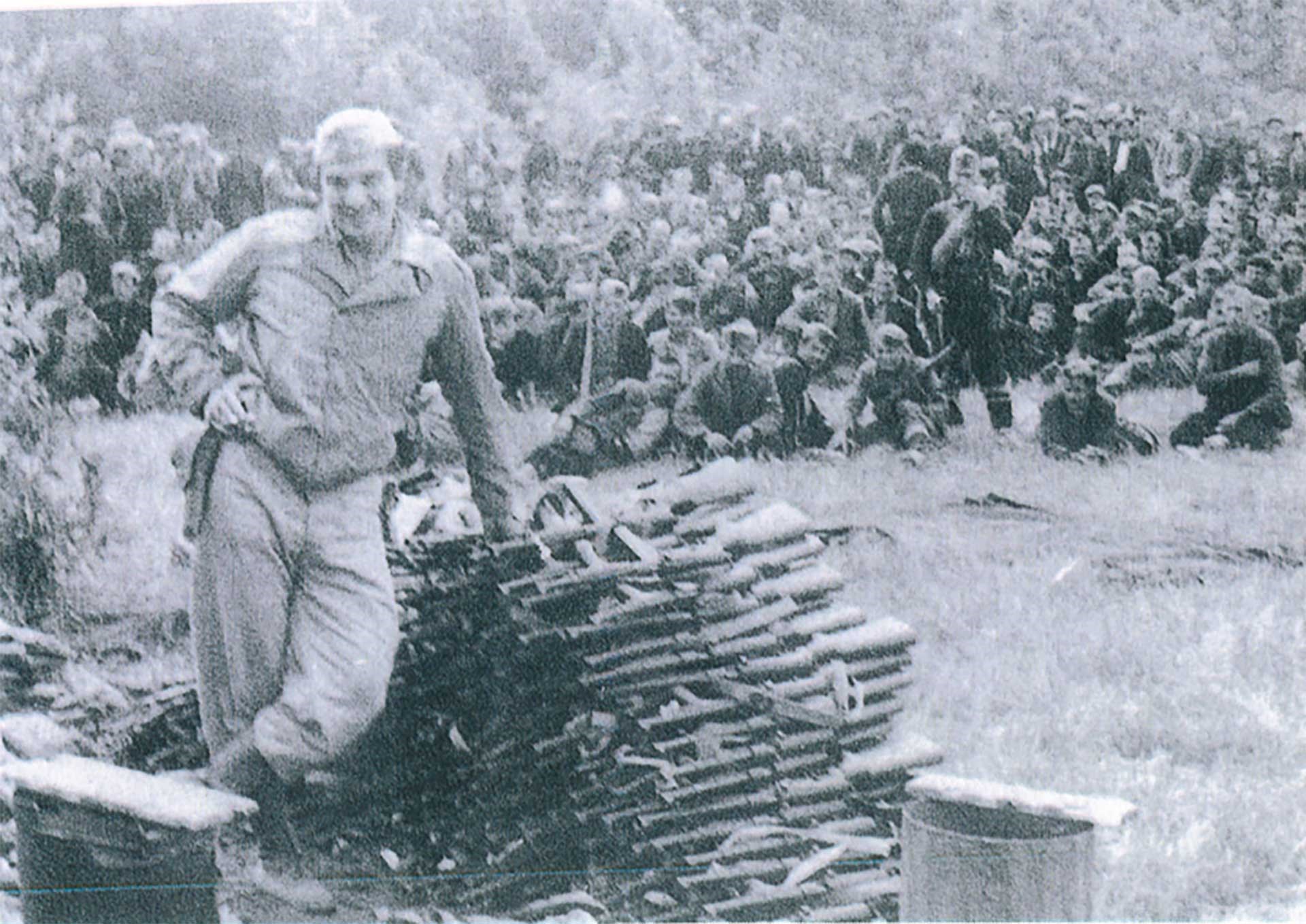 Arrangements were made for the Marlin Firearms Company to manufacture the new gun for United Defense Supply Corporation. Since production did not get underway until 1942, it was designated “UD Model 42.” (marked "UD M.’42" on the receiver). Since High Standard held the patent on the gun, the company would receive a royalty on each one sold. Even though the gun was manufactured by Marlin, the receiver was marked “United Defense Supply Corp./NEW HAVEN, CONN./UD M.’ 42/PAT. APPLIED FOR”.” Thus, as events transpired, Marlin manufactured two different types of submachine guns during WWII; the ill-fated M2 (of which only 400 were made) and the UD M.’42.
Arrangements were made for the Marlin Firearms Company to manufacture the new gun for United Defense Supply Corporation. Since production did not get underway until 1942, it was designated “UD Model 42.” (marked "UD M.’42" on the receiver). Since High Standard held the patent on the gun, the company would receive a royalty on each one sold. Even though the gun was manufactured by Marlin, the receiver was marked “United Defense Supply Corp./NEW HAVEN, CONN./UD M.’ 42/PAT. APPLIED FOR”.” Thus, as events transpired, Marlin manufactured two different types of submachine guns during WWII; the ill-fated M2 (of which only 400 were made) and the UD M.’42.
In early 1942, the Netherlands Purchasing Commission (NPC) was procuring all manner of war material and weaponry from the United States, primarily to arm colonial troops garrisoning its East Indies colonies. Guns manufactured in the United States under NPC contract during this period included the Johnson Model 1941 Rifle and Light Machine Gun.
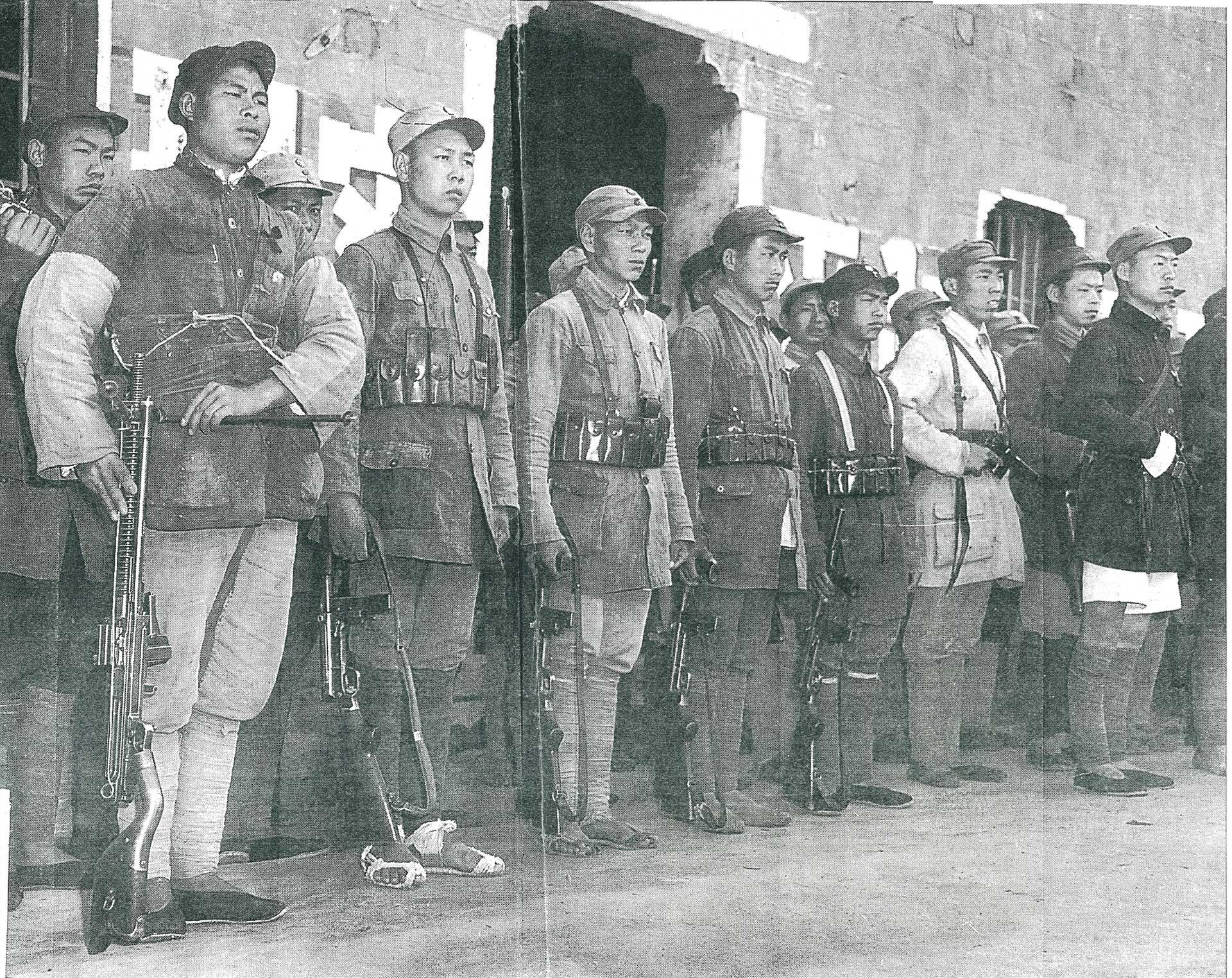 In March 1942, the NPC purchased 7,500 Marlin-made 9 mm UD M.’42 submachine guns via the United Defense Supply Corporation which was followed by a subsequent order for just over 7,500 additional guns. They were paid for by the Netherlands Purchasing Commission, but with the fall of the East Indies, the Dutch didn’t need the guns and made arrangements to sell the 15,000+ UD M.’42 submachine guns to the United States government. Many of them were procured for the Office of Strategic Services (OSS), and a sizeable number were air-dropped into France and other occupied countries to supply the various resistance movements. This is confirmed by documentation contained in the book “United States Army in World War II – Special Studies – Rearming the French” which contained the following information on the UD M’42, termed “Marlin Submachine Gun” in a table titled "Quantities of Equipment Packaged by OSS in the United Kingdom and Airdropped into France: January-October 1944"
In March 1942, the NPC purchased 7,500 Marlin-made 9 mm UD M.’42 submachine guns via the United Defense Supply Corporation which was followed by a subsequent order for just over 7,500 additional guns. They were paid for by the Netherlands Purchasing Commission, but with the fall of the East Indies, the Dutch didn’t need the guns and made arrangements to sell the 15,000+ UD M.’42 submachine guns to the United States government. Many of them were procured for the Office of Strategic Services (OSS), and a sizeable number were air-dropped into France and other occupied countries to supply the various resistance movements. This is confirmed by documentation contained in the book “United States Army in World War II – Special Studies – Rearming the French” which contained the following information on the UD M’42, termed “Marlin Submachine Gun” in a table titled "Quantities of Equipment Packaged by OSS in the United Kingdom and Airdropped into France: January-October 1944"
Gun 9mm Marlin Submachinegun, 2,405
Barrel Spare, Marlin 240
Magazine Assembly, Double, Marlin 4,800
Magazine Assembly, Single, Marlin 7,200
Magazine Pouch, Assembly, Single Marlin 1,400
Sling, Gun, Marlin, Submachinegun 2,400.”
While it is documented that just over 2,400 UD M.’42 submachine guns were air-dropped into France in 1944, period photos also depict resistance fighters and partisans of other nations, including Greece, Yugoslavia and Burma, armed with UD M.’42s. It is also reported that some of the guns were used in China and Africa as well. Unfortunately, as confirmed by Col. Rene Studler, many of the UD M.’42 submachine guns that had been air-dropped into France were subsequently captured by the Germans.
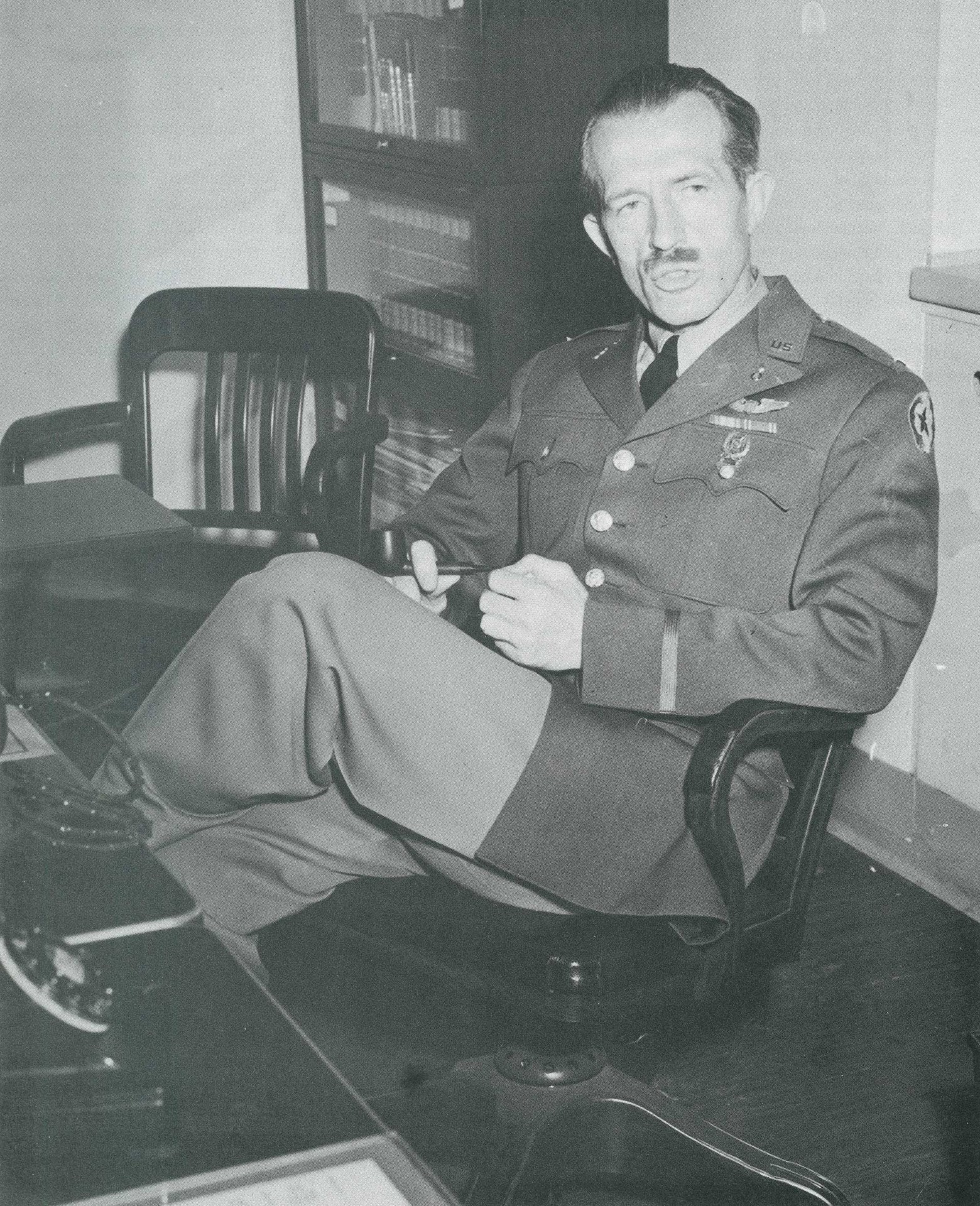
Col. Rene Studler, head of the U.S. Ordnance Department during World War II, was behind the ultimate decision to not award a U.S. military contract for the production of UD M.'42 submachine guns.
After the war, Marlin attempted to find new buyers for the UD M.’42. Some lukewarm interest was shown by Argentina and the Netherlands, but no serious buyers emerged, and the company ceased marketing efforts for the gun in 1952. As was the case with other WWII submachine guns such as the Thompson and Reising, some UD M.’42s found their way into a number of American law-enforcement agencies, but the guns were seldom employed.
Although overshadowed by the Thompson and other better-known firearms, the UD M.’42 should be recognized for the role in played in WWII. While it may not have been in the hands of U.S. Army soldiers battling their way across Europe, or wielded by Marines in the hard-fought island battles of the Pacific, the UD M.’42 aided brave partisans and OSS operatives in their fight against the foes of freedom. That’s not a bad legacy for any firearm.












